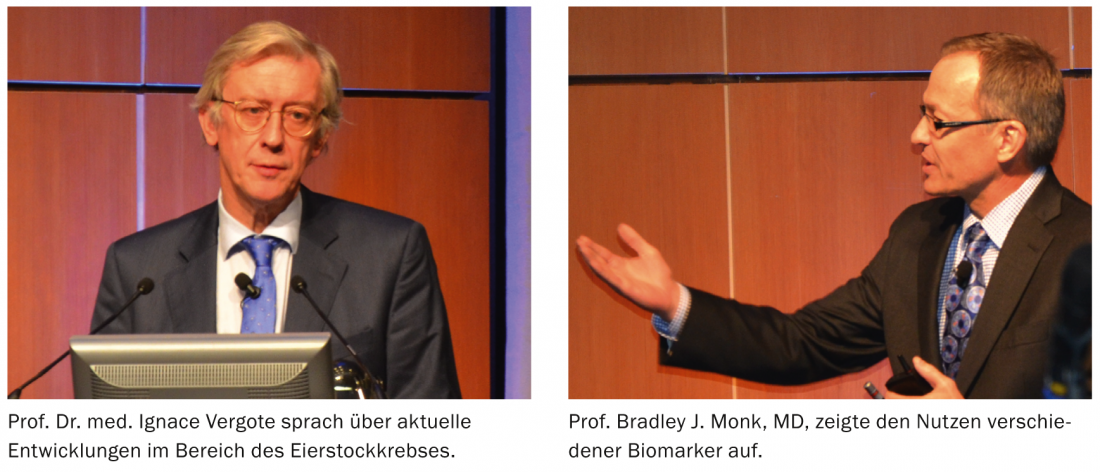At the ESMO Congress in Amsterdam, a review was given of the options available to date in the treatment of recurrent ovarian cancer. Therapy depends on the particular form of recurrence and therefore aims either mainly at symptom improvement or at prolonging progression-free survival. In the future, new biomarkers or imaging agents can be used to personalize the drug approach and thus significantly improve it in individual cases.
(ag) Prof. Ignace Vergote, MD, Leuven, presented current challenges in the field of recurrent ovarian cancer. First, the definition of this condition must be specified:
- If the treatment-free interval since the last platinum dose >is 12 months, it is referred to as a platinum-sensitive form.
- If this period is 6-12 months, one speaks of a partially platinum-sensitive form.
- If the period is <6 months, it is called a platinum-resistant form.
- If the period is <4 weeks, it is called a platinum-refractory form.
“The goals of treatment in recurrent ovarian cancer differ depending on platinum sensitivity: in resistant types (0-6 months), the main goal is symptom relief; in partially sensitive, the main goal is to stabilize the disease and delay progression or prolong progression-free survival. These goals are even more important in platinum-sensitive types,” said Prof. Vergote.

Platinum sensitive ovarian cancer
The following should be noted regarding platinum-sensitive ovarian cancer, according to Prof. Vergote:
- Secondary cytoreductive surgery may be indicated in selected patients (DESKTOP and GOG trials).
- The European Medicines Agency (EMA) has approved bevacizumab for the platinum-sensitive form.
- Other anti-angiogenic drugs, PARP inhibitors, etc. are being studied in phase II/III trials.
- Biological predictors that predict response are urgently needed to be identified.
Platinum-resistant ovarian cancer
In the platinum-resistant form, it is important to balance well the efficacy, toxicity, and timing of the active ingredients. Currently, however, the research field is experiencing a boom due to various studies on new active substances, which has already produced some interesting approaches and results. In addition to inhibiting angiogenesis, future drugs will be needed for other molecular targets that must first be confirmed genetically or by imaging.
Personalized approach
Prof. Bradley J. Monk, MD, Arizona, spoke about biomarkers: “This word has often been inaccurately applied. A biomarker is significant if it aligns with an important clinical indication, is reproducible, and provides a tangible benefit to the individual patient or improves management. This also always means very accurate validation of the biomarker and thus a good understanding of the underlying mechanisms.”
There are prognostic and predictive biomarkers. The former refer to individuals who are already ill. They are useful in predicting the outcome of treatment by comparing marker-positive with marker-negative patients without varying the drug intervention. Predictive biomarkers can be used to predict the outcome of specific targeted treatment in different populations. This can be useful in selecting a therapy for patients on an individual basis. For example, in platinum-sensitive recurrent serous ovarian cancer, one such treatment is PARP inhibitors. The treatment success seems to be partially dependent on the BRCA mutation.
Concomitant imaging agents may also predict response, e.g., etarfolatide. It binds to the folate receptor, which is overexpressed in several cancers, including ovarian cancer, indicating the location of the tumor and the potential response to treatment (e.g., using vintafolide, which is currently in development).
Current developments
Several promising drugs are in the pipeline:
Vintafolide: Vintafolide has orphan drug status and is currently under review in the EU based on data from the PRECEDENT study. Filing for approval in the U.S. is expected in 2015, based on the currently ongoing Phase III PROCEED trial.
MK-1775: MK-1775 is the only WEE1 kinase inhibitor currently in clinical development. It is an oral therapy that could be used in p53-deficient tumors. MK-1775 interferes with the G2 DNA “damage checkpoint” (by inhibiting WEE1), making tumor cells more vulnerable to chemotherapeutic agents that induce DNA damage. In combination with a DNA-destroying chemotherapy agent, this appears to allow promising response rates to be achieved in the platinum-refractory setting.
Source: “Is Personal Medicine a Reality for Recurrent Ovarian Cancer Patients?”, MSD satellite symposium at ESMO Congress, September 27-October 1, 2013, Amsterdam.
InFo Oncology & Hematology 2014; 2(1): 37-38.












